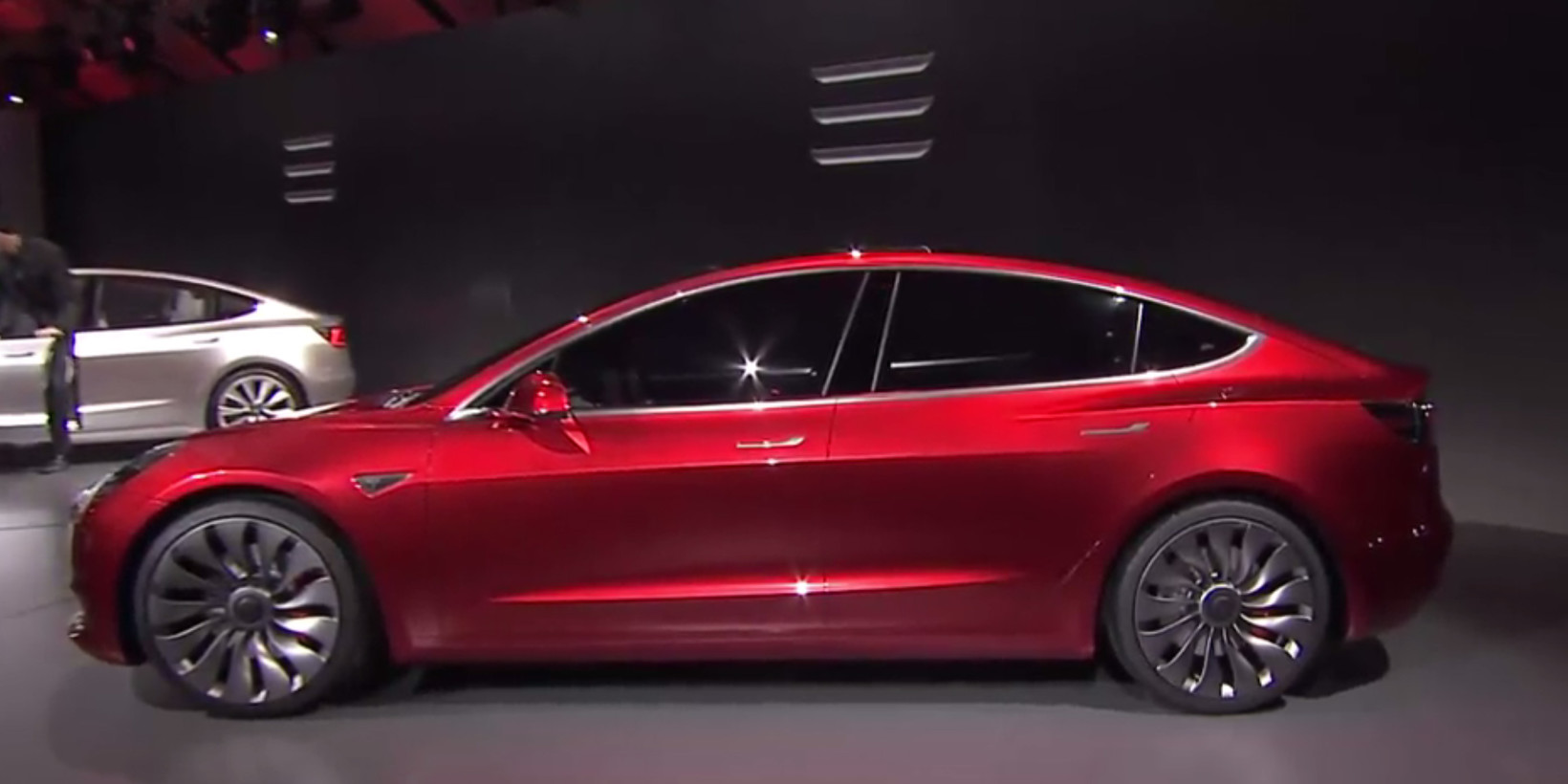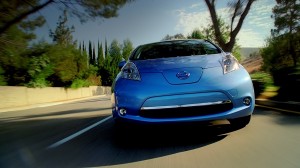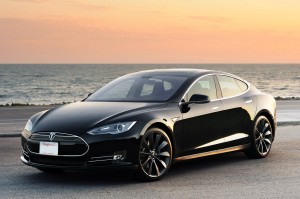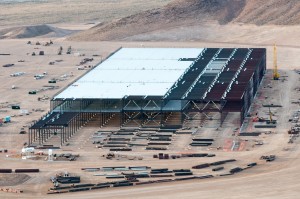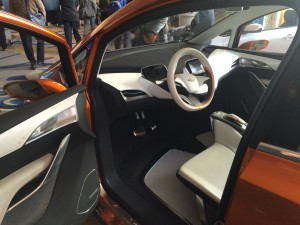Elon Musk did his big reveal last night on the long-awaited Tesla Model 3, the most anticipated mass-market electric vehicle. The vehicle promises some pretty amazing things, mainly a minimum 215-mile range at a base price of $35,000. Meanwhile, it will have autopilot features now found on the company’s electric SUV Model X.
How can they do all this for that price? The answer is the “gigafactory” for batteries outside Reno, currently under construction. As Musk describes in the video above, it’s the largest footprint building in the world that will produce more lithium ion batteries than all other facilities in the world combined. Now that’s a textbook example of economies of scale.
And in terms of look, it’s hard to deny that this is one sporty-looking performance vehicle, with an all-glass roof (hello squeegees!) and sleek, Porsche-like lines:
Meanwhile, as of last night, over 115,000 people have already deposited $1,000 to pre-order one.
It’s hard to deny that this is a historic moment in the history of electric vehicles, and by extension sustainable transportation. While the Chevy Bolt promises similar range and price, Tesla has the cache and history of innovation to deliver a market winner for the masses.
But the car won’t be available for probably another two years. So what does that mean for the industry in the interim?
The effect could actually be counter-productive for the electric vehicle industry. With such an appealing car waiting in the wings, why would someone want to buy one of the existing models out there now, when they’re priced about the same but have less than half the range of the Model 3 and none of the cool features or glitz?
Just as an example, think of the “new” Nissan LEAF. After five years in production, the new version from Nissan basically looks the same as the original and only has 20 additional miles of range, to 105 miles. And it costs about $32,000 before incentives. So why would I buy that LEAF now when in two years, for the same price, I can get more than twice the range and all the excitement and features of a Tesla?
For buyers like me who want to stay electric, we’ll probably just continue leasing, in order to wait out the next two years until the Model 3 and possibly other models like it are on the market. While this dynamic has always been present to some extent (the belief that the technology is improving so rapidly it’s not worth investing in a new EV just yet), the Model 3 unveil could put that psychology on steroids.
If I were working at Nissan, Chevy or BMW right now, I’d sure be worried about this trend. And I’d also be on notice that the whole industry needs to up its game in response to the Model 3.
Electric vehicles have had a down year, and many people blame low gas prices, per the Associated Press:
At their peak in 2013, with gas averaging $3.50 per gallon, Americans bought only 341,000 hybrids and electrics, about 2.2 percent of total U.S. car sales, according to Kelley Blue Book.
Companies spent millions developing the cars, taking losses to meet government fuel economy standards that gradually increase and require the new-car fleet to average 54.5 miles per gallon by 2025.
As gas prices fell below $2 per gallon, sales of hybrids and electrics dropped further. Last year, automakers had 16 hybrid and electric models on sale, but sales sank to just over 274,000.
But poor marketing is a big part of the story, too. Many automakers tried to sell the vehicles as an eco-friendly alternative or competitor to the popular hybrid vehicles like the Toyota Prius. That might explain why the Nissan LEAF is called a “leaf” and looks vaguely like a goofy Prius.
But in their haste to please the eco crowd, these automakers were overlooking one critical attribute of an electric vehicle: they are fun to drive.
Tesla realized this early on, and as a result have successfully positioned their vehicles not just as an eco-toy for the rich but as a new and exciting technology that drives better than clunky old gas cars. In fact, most Tesla buyers don’t actually care about the environment but instead are interested in access to new technology.
But now with gas prices so low, other automakers are coming around to marketing the performance aspect, from the same article:
At the New York International Auto Show on Wednesday, Hyundai and Toyota showed off new electric and hybrid vehicles, with presenters from both companies touting them as “fun to drive.” Hyundai unveiled battery, gas-electric hybrid and plug-in versions of a new car called the Ioniq, while Toyota showed the plug-in Prius Prime, which can go 22 miles on electricity before the gas-electric power system kicks in. The electric range is double the old version.
It’s better late than never. There’s a much bigger market of people who want a fun car to drive than people who care about climate change and Saudi Arabia. So this is a good and long overdue pivot.
But perhaps more importantly, Tesla’s Model III (to be unveiled this week) and the Chevy Bolt — both 200-mile range vehicles for under $40,000 — will herald the beginning of truly mass-market EVs that can appeal to a broader market segment.
It will take some time, but between better marketing and vehicles with improved range at a lower cost, the battery electric revolution in driving will be here to stay.
And no other single technology could be more welcome for combating climate change.
California regulators have been busy approving “pilot” projects for utilities to start paying for EV charging infrastructure, at significant ratepayer expense. Last week, they approved PG&E’s controversial plan, which had the blessing of environmentalists and unions, while ratepayer advocates and the San Francisco Chronicle cried foul. It will target a deployment of 7,500 level 2 charging ports and 100 DC fast-charging ports.
And with the passage of SB 350 last year, utilities will be entering the EV charging game big time in the coming years. These pilots are just the initial salvo.
But the state had already required $100 million in EV charging investment from NRG/eVgo as part of a legal settlement in 2012. That company has been badly behind schedule on getting these stations up and running, leading regulators to call for an audit over a year ago.
The status of the audit? Well, I emailed the California Public Utilities Commission recently to find out, and they told me they just hired an auditor to do this work at the end of February. No explanation was offered as to why that took the agency a whole year to do so.
So while regulators are busy ushering utilities into the EV charging world, they’re asleep at the wheel monitoring the state’s $100 million investment already in the works. Not a good sign as utilities start spending big ratepayer bucks on EV charging.
From a clean tech perspective, Nevada’s been getting lots of bad press recently for killing its rooftop solar industry. But a recent announcement and ceremony on EV charging puts them in a better light, at least on electric vehicles (of course, by killing rooftop solar, the state is making it less likely people will want to buy EVs).
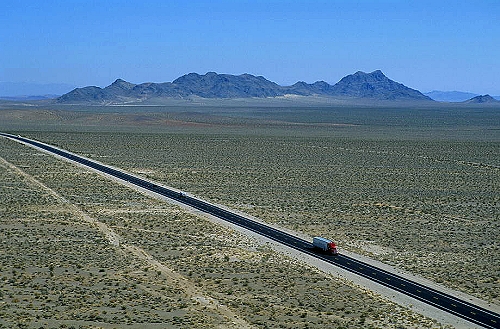 Highway 95 between Las Vegas and Reno connects Nevada’s two biggest cities. I’ve done the drive twice, including last summer, and I think it’s one of the most beautiful, desolate roads in the country. It’s also super dangerous — I saw accidents each time I drove it, due to the two-lane configuration, blurry rural vistas, lots of cars, and lots of passing that narrowly misses oncoming traffic.
Highway 95 between Las Vegas and Reno connects Nevada’s two biggest cities. I’ve done the drive twice, including last summer, and I think it’s one of the most beautiful, desolate roads in the country. It’s also super dangerous — I saw accidents each time I drove it, due to the two-lane configuration, blurry rural vistas, lots of cars, and lots of passing that narrowly misses oncoming traffic.
But it’s nice to see that soon EV drivers can make that trip without stress (at least related to running out of juice):
About 40 people — a mix of Valley Electric Association board members and executives, residents of the small town that is the gateway to Death Valley National Park, employees of Eddie World, an iconic stopover on the seven-hour trip between Las Vegas and Reno, and curious travelers on U.S. Highway 95 — gathered to watch Sandoval and others cut a ribbon marking the official opening of the charging stations.
There are two charging stations at the site with three ports each. Two of the ports have connections that will fully charge a vehicle in four hours, but one of them has a fast charge that can take a vehicle to 80 percent charged within 30 minutes.
“It was just great looking out in the crowd and seeing all the happy faces of the people of Beatty because they know that they will always know they were the first to have this,” Sandoval said after the 20 minutes of remarks by several dignitaries.
The opening of the Beatty charging station is the first of four planned along U.S. 95, the 448-mile primary route between the state’s two most populous cities, Las Vegas and Reno.
Other stations are planned in Tonopah, Hawthorne and Fallon. Sandoval said he plans to celebrate them all.
What’s crazy is that California has not done the same level of planning and infrastructure investment for its key highways. That includes both Highway 99 in the eastern Central Valley and Interstate 5 connecting L.A. to the Bay Area and Sacramento, not to mention Interstate 101.
At least on EVs, California has something to learn from Nevada.
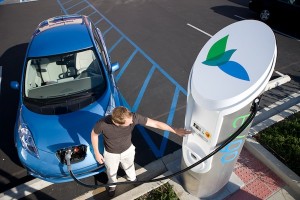 Lots of recent news on EV infrastructure:
Lots of recent news on EV infrastructure:
- The California Public Utilities Commission approved a major new utility investment in EV charging infrastructure this week, allowing San Diego Gas & Electric to install charging stations at “up to 350 businesses and multi-family communities throughout the region, with 10 chargers at each location for a total of 3,500 separate chargers,” per Clean Technica. At least 10% of the chargers will be in disadvantaged communities. It’s a step in the right direction, as electric utilities probably provide the best hope for getting adequate infrastructure up and running for EVs in the long run.
- The California Energy Commission is finally soliciting bids to put fast chargers in key travel corridors in California. Some of the prime routes include I-15 north of Victorville to outside of Las Vegas, I-10 from Beaumont past Palm Springs, and I-80 from Auburn out to Lake Tahoe. It’s about time.
- Tesla is killing it on their proprietary network of supercharger sites, adding about 50% more chargers in 2015 alone, per Green Car Reports. The company is on its way to becoming a vertically integrated monopoly. Imagine if GM owned all the great cars, plus all the gas stations and dealerships. That’s the path Tesla is on.
- But sadly, NRG is still lagging on their implementation of the $100 million settlement with the California Public Utilities Commission. The audit of their performance, announced over a year ago by the commission, has so far failed to materialize. I called the agency for a status update a few months ago and never heard back. In some ways, their failure to meet the terms of the agreement has created the need for more public dollars to go to this charging infrastructure investment, while Tesla’s success makes NRG’s slow progress look even worse by comparison.
In general, the infrastructure news is positive. But sales of plug-in electrics are still lagging due to cheap gas, failure to introduce new models with better range, and poor marketing. More work to be done, but this all-in-all a good start.
The Reno Gazette-Journal checks in for an update on the battery megafactory, and the results are mixed to date:
The Tesla-Panasonic battery gigafactory is falling far short of the economic impact projections on jobs and capital investment used to persuade lawmakers to approve a record-breaking tax incentive package for the project, according to an analysis by the Reno Gazette-Journal.
According to the review of available public documents, the project has generated just a fraction of the jobs, payroll and capital investment projected for the first year in a study commissioned by the Governor’s Office of Economic Development during the 2014 special session.
The numbers also have not kept up with the more refined projections used by Tesla in its application for incentives that will allow the company to operate tax free for a decade and with substantially reduced taxes for a second decade.
Nevada leaders don’t sound worried because the tax benefits go away if certain benchmarks aren’t met. And the factory is already starting to produce home batteries for stationary energy storage.
At this point, it’s probably not a cause for concern, although it may be an indication that construction isn’t where Tesla hoped to be at this point.
Long term, the real value in the Gigafactory for the Reno area is not in construction jobs, but in the higher-paid engineering and other high-skilled jobs that will be located on-site, plus all the supply and service industries that will spring up as a result nearby.
At least Nevada leaders hope that’s the case, given the tax breaks they gave Tesla to lure them there in the first place.
It’s finally started:
Southern California Edison received the green light today from state regulators to begin a pilot project to support installation of as many as 1,500 electric vehicle charging stations within its service territory.
The California Public Utilities Commission’s approval clears the way for SCE to begin implementing its $22 million “Charge Ready” program to get more electric vehicle charging stations installed in locations where people park their cars for extended periods of time. For example, at workplaces, campuses, recreational areas and apartment and condominium complexes.
And it’s just the beginning, as this pilot was in the works before SB 350 passed, which gives utilities an even bigger opportunity to replace Big Oil in California as the transportation fuel provider of choice.
Some ratepayers may complain, but it’s good news for electric vehicle drivers. And over the coming decade, that will include more and more people.
In his State of the Union speech this week, President Obama spent a lot of time discussing energy and the country’s progress on clean technology and lowering carbon emissions. He specifically referenced the 2009 stimulus investments:
Seven years ago, we made the single biggest investment in clean energy in our history. Here are the results. In fields from Iowa to Texas, wind power is now cheaper than dirtier, conventional power. On rooftops from Arizona to New York, solar is saving Americans tens of millions of dollars a year on their energy bills, and employs more Americans than coal – in jobs that pay better than average. We’re taking steps to give homeowners the freedom to generate and store their own energy – something environmentalists and Tea Partiers have teamed up to support. Meanwhile, we’ve cut our imports of foreign oil by nearly sixty percent, and cut carbon pollution more than any other country on Earth.
As the New York Times reports, however, some experts are disputing these claims:
“That paragraph as it relates to energy and climate issues — I thought it was the most troubling paragraph of the whole speech,” said David Victor, an expert on energy policy at the University of California, San Diego. “It’s very hard to attribute the bulk of what’s happening now in terms of bending the emissions curve and increasing renewables specifically to the stimulus.”
The article does a good job going through the arguments on both sides.
To my mind, the stimulus was critical for boosting clean technology by extending existing tax credits for renewable investments and converting them to much-needed cash grants. It also provided life-saving loans for critical companies Tesla, as well as highly effective tax credits for electric vehicle purchases. Finally, it funded advanced research in clean technology through the most important new agency on climate change in the federal government, ARPA-E.
But it’s worth putting this progress in context. For example, California, an economy larger than India, has boosted demand greatly for solar through state policies, as have the majority of states in the union. China has brought down solar panel costs dramatically with manufacturing investments. And the switch to natural gas from coal, brought about by technology changes related to fracking, are largely responsible for the country’s reduction in carbon emissions.
Still, it’s been a confluence of events that has resulted in the progress we’ve made to date, and I think it’s fine for Obama to take credit as he did. The efforts of his administration have been a necessary — but probably not sufficient — part of that success.
Are self-driving cars just around the corner, or years away? The media and certain business leaders are hyping the technology in the pure optimism camp, while academics and other researchers seem much less sure.
On the optimism side, you can now summon a Tesla to your front door from its parking spot, or send it from your front door to go park, with the “Autopark” feature. And Elon Musk calls this just a “baby step” with more ambitious self-driving features just around the corner:
Tesla Motors Inc. Chief Executive Officer Elon Musk said within two years a customer would be able to summon an electric car to drive autonomously from Los Angeles to New York.
“I might be slightly optimistic on that, but I don’t think significantly optimistic that we can do that in two years,” Musk said in a press conference on Sunday. He added that it should be technically feasible to have fully autonomous vehicles within 24 to 36 months.
But then you read reports of self-driving researchers who throw cold water on this kind of optimism:
Everyone wants to reduce the global death toll of 1.2 million from car accidents annually, but how do we get on the path to vehicles that are virtually incapable of crashing? There’s a lot of cheerleading out there, and vague talk about vehicles being on the road in a year or two. “In truth, we’re a long way from autonomous cars,” [Dr. Gill Pratt, head of the new Toyota Research Institute] said. “We can perform reliably at certain speeds, and under certain weather conditions. But what we’ve accomplished are the relatively easy things.”
Pratt set the industry a rather daunting goal. Sure it’s great that autonomous cars have been tested in millions of miles of driving, but we need trillions of miles on the road. Figuring out how to make that happen is the team’s challenge. Part of that is measuring how humans react in emergency conditions while piloting the cars already on the road. Pratt pointed out that Toyota, now the world’s biggest automaker, currently sells 10 million cars around the world annually, and that 100 million Toyotas are on the road at any one time—covering a billion miles per year.
Hard to know what to make of it, but it could be a case where business leaders like Musk pull inherently cautious researchers like Pratt out of their comfort zones to bring the technology to market faster than they’d otherwise like. The result could be that we end up somewhere in the middle of these predictions.
Forget auto shows, as the International Consumer Electronics Show in Las Vegas seems to be getting all the snazzy new vehicles, particularly the electric ones. General Motors picked the occasion to announce finally the 200-mile range, $30K “Bolt”:
[Ms.] Barra said on Wednesday that G.M. is “committed to electrification” despite the lagging sales of current electric cars and hybrids. Others at G.M. said the new Bolt could change consumers’ perception of purely electric cars as strictly for commuting and other short trips.
“All of our research shows the buyer consideration goes up dramatically with a range of over 150 miles,” said Pam Fletcher, G.M.’s chief engineer for electric vehicles.
GM is also partnering with Lyft for an all-electric rideshare service, which one day may include driverless vehicles. Not to mention that secretive Faraday Futures automaker unveiled its concept race car to the masses.
It’s a fascinating convergence of software and battery technology that we’re living through, and it will change our transportation landscape dramatically in the coming decade.

